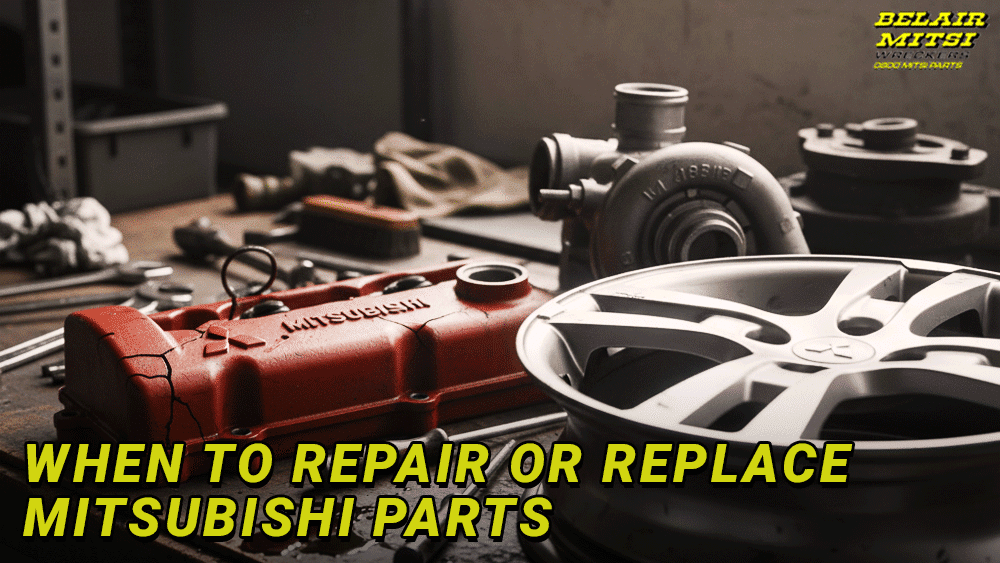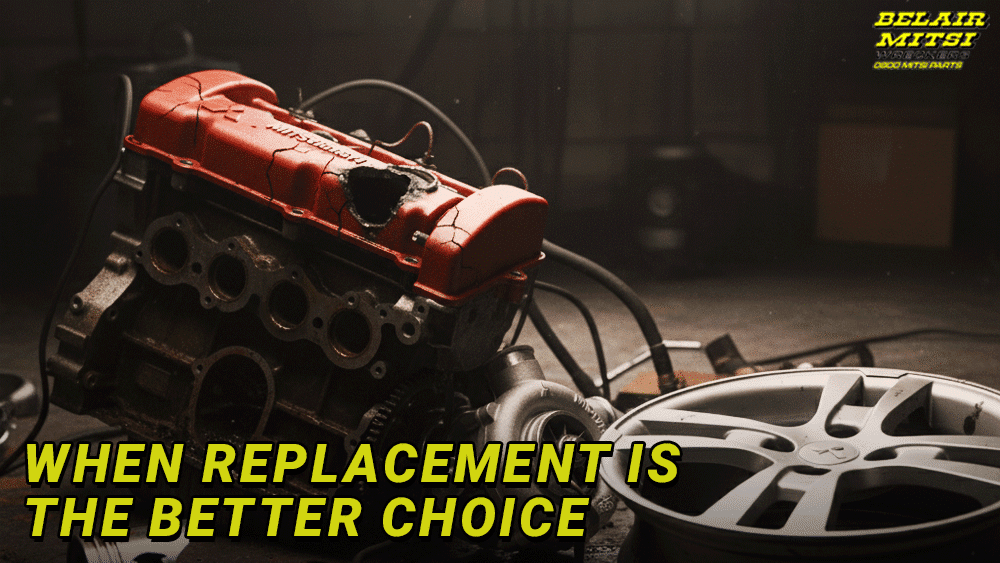
Mitsubishi cars are known for being strong and reliable, which is why many people choose them. But like any car, they need regular care to stay safe and work well. Over time, important Mitsubishi parts like brake pads, filters, belts, suspension, and tyres wear out. Knowing when these parts need fixing or replacing can help you avoid unexpected breakdowns and expensive repairs.
Many owners find it hard to know exactly when their car needs attention. Missing early signs of worn parts can put your safety at risk and cause bigger problems. This guide will help you spot common warning signs, show you which Mitsubishi parts often need care, and explain when a repair is enough or when a part needs to be replaced. By staying aware and acting early, you can keep your Mitsubishi running smoothly for a long time.
It’s important to notice the early signs that parts of your Mitsubishi might be wearing out. Catching problems early helps you avoid bigger repairs and keeps your car safe and reliable.
One of the most noticeable warning signs is strange sounds coming from your vehicle. Squealing, grinding, rattling, or knocking noises may suggest problems with the brakes, suspension, or engine components. For instance, a high-pitched squeal when braking often indicates worn brake pads that need immediate attention. Similarly, knocking sounds during acceleration or over bumps could point to issues with the suspension or engine mounts.
If your Mitsubishi starts to feel less responsive or handles differently, it could be a symptom of parts wearing out. This might include:
Modern Mitsubishi models feature an advanced onboard diagnostic system that activates warning lights on the dashboard. Warning lights may indicate engine issues, brake system concerns, or tyre pressure problems, among other alerts.
Prompt attention to dashboard indicators, along with consulting the vehicle’s manual, helps address minor faults early. Taking quick action prevents small problems from developing into serious and costly repairs.
Leaks beneath your vehicle or unusual smells such as burning or fuel could be early signs of worn seals, damaged hoses, or engine issues. These warning signs should not be ignored, as they may pose safety risks or indicate more serious mechanical problems.
By staying alert to these early signs, you can book a timely inspection or minor repair that may save you from more expensive and dangerous breakdowns down the line.
While many components in your Mitsubishi may eventually require servicing, some parts are more prone to wear and tear due to their role in everyday vehicle operation. Understanding which parts commonly need attention can help you focus your maintenance efforts wisely.
The braking system is arguably the most critical safety feature in any car. Brake pads, which press against brake discs to slow your vehicle, naturally wear down with use. Worn pads reduce braking efficiency, increase stopping distances, and can damage brake discs if not replaced promptly.
Filters are essential for protecting your engine from dirt, debris, and impurities. Over time, air filters become clogged, reducing engine performance and fuel efficiency. Oil filters trap contaminants in the engine oil, which, if left unchanged, can accelerate engine wear. Fuel filters prevent impurities from reaching the engine’s fuel injection system. Regular replacement of these filters is crucial for smooth engine operation.
Belts like the timing belt and serpentine belt are essential for your Mitsubishi’s engine to run smoothly. When these belts become worn, cracked, or stretched, they may fail unexpectedly. Similarly, hoses that carry coolant and other fluids can weaken or leak, which could cause the engine to overheat.
Parts such as shock absorbers, struts, and bushings help keep your vehicle stable and comfortable. Worn suspension components can affect handling, increase tyre wear, and lead to uneven braking.
Tyres are the only part of your car that touch the road. If they’re worn or damaged, they won’t grip well, and your stopping distance will be longer, which can be dangerous. It’s important to check the tread depth, wear, and any damage regularly.
Not every sign of wear calls for immediate replacement. Some components can be repaired or refurbished, often saving time and money while prolonging the part’s useful life.
Filters are often straightforward to replace, but in some cases, air filters can be cleaned to restore airflow temporarily. Oil and fuel filters generally require full replacement during scheduled servicing.
If brake pads are only slightly worn or brake discs have minor surface imperfections, resurfacing the discs can extend their life. However, this must be done cautiously and by a professional.
Belts that have become loose may require adjustment, and minor hose leaks can sometimes be temporarily patched. However, these are usually short-term fixes until a full replacement can be carried out.
Some suspension parts, like rubber bushes, can be replaced without changing the entire suspension system, restoring stability and comfort.
Choosing repair over replacement often depends on the part’s condition, age, and safety implications. When in doubt, consult a professional mechanic to assess whether repair is viable or if replacement is the safer option.

Repairs can work for small issues, but sometimes it’s safer to replace parts, especially those important for your safety and the car’s condition.
If brake discs are warped, cracked, or worn below the manufacturer’s minimum thickness, replacement is essential. Similarly, brake pads that are worn down to their metal backing should be replaced immediately to avoid damage to the discs and loss of braking power.
Timing belts are subject to strict replacement intervals because their failure can cause catastrophic engine damage. Always follow Mitsubishi’s recommended schedule for belt replacement to avoid costly repairs.
When suspension components become damaged or fail to dampen road shocks effectively, replacement improves safety, ride comfort, and tyre life.
Tyres must be replaced once the tread depth falls below legal limits or if they develop sidewall damage, punctures, or severe uneven wear.
Faulty sensors or wiring often require replacement to restore proper vehicle function and accurate warning systems.
Replacing parts with genuine Mitsubishi components ensures the highest quality, proper fit, and long-term reliability.
When it comes to replacement parts, not all options are equal. Genuine Mitsubishi parts offer significant advantages over generic or aftermarket alternatives.
Genuine parts are designed specifically for Mitsubishi vehicles, guaranteeing exact fit and seamless integration with existing systems. This precision reduces installation time and potential issues caused by poor fitment.
Original parts use high-quality materials and manufacturing standards, which often translates into longer service life and better performance under stress.
Using genuine parts is essential to keep your vehicle’s warranty valid. Warranties may be cancelled if damage is caused by non-approved or aftermarket parts.
Since genuine parts are engineered for your specific model, they help maintain the car’s intended performance, fuel efficiency, and safety standards.
Mitsubishis that are properly maintained using genuine parts usually hold their value better, as prospective buyers trust the vehicle’s condition and maintenance record.
Some small jobs can be done yourself, but it’s best to have a qualified mechanic check and fix any problems to make sure the work is done properly.
Professional technicians use specialised tools and knowledge to thoroughly inspect your vehicle and identify worn parts, even those not immediately obvious.
Incorrect installation of parts can cause premature failure or safety hazards. Professionals ensure parts are fitted correctly, following manufacturer guidelines.
Authorised service centres and reputable garages have access to genuine Mitsubishi parts and technical support, which reduces the risk of errors and substandard replacements.
Skilled mechanics can give you customised advice on servicing intervals and future repairs, making it easier to budget and avoid sudden issues.
Preventive care is the best way to ensure your Mitsubishi’s parts last as long as possible and avoid unexpected failures.
Keeping up with your Mitsubishi’s service schedule is essential for maintaining its reliability. Routine tasks such as oil changes, filter replacements, and brake inspections help ensure key components continue to function efficiently.
Regular servicing also allows mechanics to spot potential issues early, reducing the risk of costly repairs. Staying on schedule helps your vehicle perform better and last longer.
A quick visual inspection of your tyres, lights, fluid levels, and brakes can make a significant difference. These checks help you spot issues such as low brake fluid, worn tyres, or blown bulbs before they develop into major problems.
Checking your lights and brakes regularly helps keep your car safe and roadworthy. Making this a routine prevents small issues from turning into expensive repairs later on.
How you drive directly impacts the longevity of your vehicle’s parts. Smooth acceleration and braking help reduce stress on the engine, brakes, and transmission.
Avoiding potholes and rough roads also protects the suspension and tyres from unnecessary damage. A careful and considerate driving style not only enhances safety but also helps extend the life of your vehicle.
Keeping your Mitsubishi clean prevents dirt, grime, and salt buildup, which can lead to rust and corrosion. Regular washing, especially in winter or near coastal areas, helps preserve the paint and underbody.
Proper storage, such as parking in a garage or using a car cover, shields your vehicle from harsh weather. This protects seals, electronics, and exposed parts from environmental wear.
Using genuine Mitsubishi parts is essential for keeping your vehicle in top condition. Authentic components help maintain safety, ensure reliable performance, and protect the long-term value of your car. By sourcing original parts from trusted suppliers like Belair Mitsubishi Wreckers, you can be confident your vehicle meets the standards set by the manufacturer and avoid costly repairs in the future.
Regularly monitoring your car for signs of wear and prioritising key parts such as brakes, filters, and tyres will keep your Mitsubishi running smoothly. Coupled with professional servicing, these practices guarantee that your vehicle stays safe and efficient, ready to provide a dependable driving experience every time you hit the road.